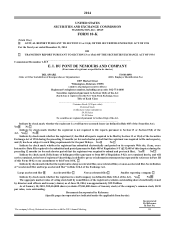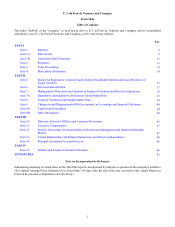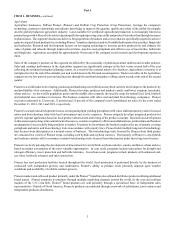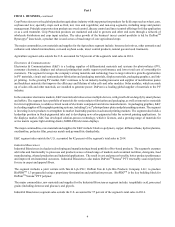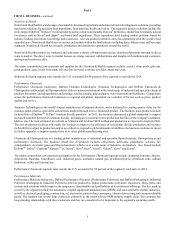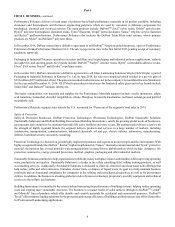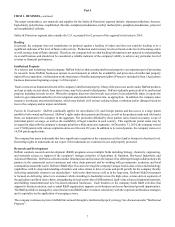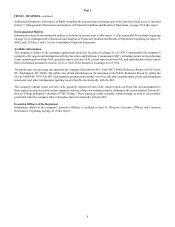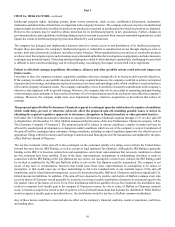DuPont 2014 Annual Report Download - page 8
Download and view the complete annual report
Please find page 8 of the 2014 DuPont annual report below. You can navigate through the pages in the report by either clicking on the pages listed below, or by using the keyword search tool below to find specific information within the annual report.
Part I
ITEM 1. BUSINESS, continued
7
The major commodities, raw materials and supplies for the Safety & Protection segment include: aluminum trihydrate, benzene,
high density polyethylene, isophthaloyl chloride, metaphenylenediamine, methyl methacrylate, paraphenylenediamine, polyester
and terephthaloyl chloride.
Safety & Protection segment sales outside the U.S. accounted for 62 percent of the segment's total sales in 2014.
Backlog
In general, the company does not manufacture its products against a backlog of orders and does not consider backlog to be a
significant indicator of the level of future sales activity. Production and inventory levels are based on the level of incoming orders
as well as projections of future demand. Therefore, the company believes that backlog information is not material to understanding
its overall business and should not be considered a reliable indicator of the company's ability to achieve any particular level of
revenue or financial performance.
Intellectual Property
As a science and technology based company, DuPont believes that securing intellectual property is an important part of protecting
its research. Some DuPont businesses operate in environments in which the availability and protection of intellectual property
rights affect competition. (Information on the importance of intellectual property rights to Pioneer is included in Item 1 Agriculture
business discussion beginning on page 3 of this report.)
Trade secrets are an important element of the company's intellectual property. Many of the processes used to make DuPont products
are kept as trade secrets which, from time to time, may be licensed to third parties. DuPont vigilantly protects all of its intellectual
property including its trade secrets. When the company discovers that its trade secrets have been unlawfully taken, it reports the
matter to governmental authorities for investigation and potential criminal action, as appropriate. In addition, the company takes
measures to mitigate any potential impact, which may include civil actions seeking redress, restitution and/or damages based on
loss to the company and/or unjust enrichment.
Patents & Trademarks: DuPont continually applies for and obtains U.S. and foreign patents and has access to a large patent
portfolio, both owned and licensed. DuPont’s rights under these patents and licenses, as well as the products made and sold under
them, are important to the company in the aggregate. The protection afforded by these patents varies based on country, scope of
individual patent coverage, as well as the availability of legal remedies in each country. This significant patent estate may be
leveraged to align with the company’s strategic priorities within and across segments. At December 31, 2014, the company owned
over 27,000 patents with various expiration dates over the next 20 years. In addition to its owned patents, the company owns over
16,500 patent applications.
The company has many trademarks that have significant recognition at the consumer retail level and/or business to business level.
Ownership rights in trademarks do not expire if the trademarks are continued in use and properly protected.
Research and Development
DuPont conducts research and development (R&D) programs across multiple fields including biology, chemistry, engineering,
and materials science in support of the company's strategic priorities of Agriculture & Nutrition, Bio-based Industrials, and
Advanced Materials. DuPont accelerates market introductions and increases the impact of its offerings through collaboration with
partners in the commercial sector (customers and value chain partners) and by working with governments, academia, and local
communities around the world. DuPont’s R&D objectives are to leverage the company's unique world-class science and technology
capabilities with its deep understanding of markets and value chains to drive revenue and profit growth for the company thereby
delivering sustainable returns to our shareholders - both in the short-term as well as in the long-term. DuPont's R&D investment
is focused on delivering value to its customers while extending its leadership across the high-value, science-driven segments of
the agriculture and food value chains, strengthening its lead as provider of differentiated, high-value advanced industrial materials,
and building transformational new bio-based industrial businesses. Each business in the company funds R&D activities that
support its business mission, and a central R&D organization supports cross-business and cross-functional growth opportunities.
The R&D portfolio is managed by senior business and R&D leaders to ensure consistency with the corporate and business strategies
and to capitalize on the application of emerging science.
The company continues to protect its R&D investment through its intellectual property strategy. See discussion under "Intellectual
Property".

